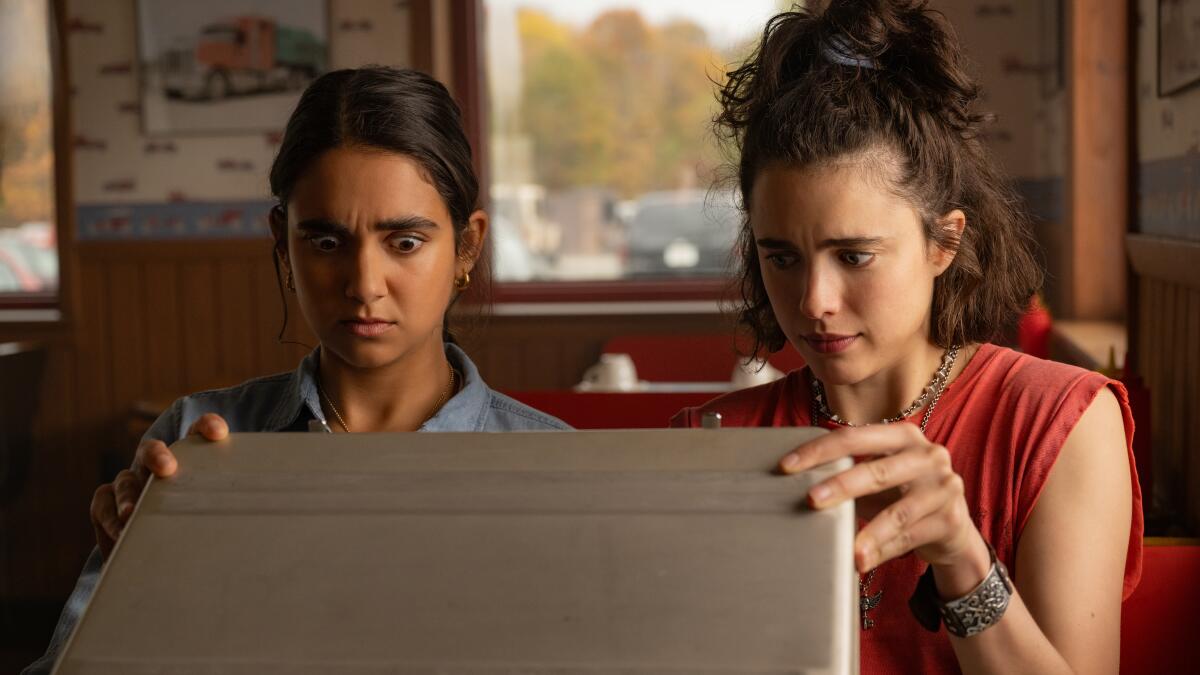
The Coen Brothers are one of Hollywood’s most prolific directing duos, bringing story after story to audiences for the past 40 years. But only recently have they embarked on solo efforts. The pair are known for bringing a subversive spin, so it’s no surprise that Joel Coen would try his hand at doing so with Shakespeare. The Tragedy of Macbeth is one of the most unique takes on one of the playwright’s most famous stories. It also felt like a big, surprising swing for a first solo endeavor. Many have been waiting to see what Ethan Coen would cook up on his own – and it’s nowhere near similar. Drive-Away Dolls is a sex-fuelled lesbian comedy caper. It’s a film so unserious, so delightful offbeat that it doesn’t care to impress or pander to high-brow sensibilities.
Set in 1999, the film takes much of its inspiration from the B-movies of the late 1960s and early ‘70s, resembling pulpy sexploitation films like Russ Meyer’s Faster, Pussycat! Kill! Kill! and Doris Wishman’s Bad Girls Go to Hell. Challenging both the censors and taboos, these films changed the way sex and nudity were seen on screen, which reflected the very free, hippy vibes of the era. Drive-Away Dolls plays on the latter too. Throughout the film, there are cuts to imagery that make you feel like you’re on an acid trip, with vibrant colors and shapes moving like the wax inside a lava lamp. While these psychedelic visuals do emphasize the film’s era of influence, the meaning behind these scenes in the overall context of the story is a bit hard to pinpoint.
Originally titled Drive-Away Dykes, this road film follows two lesbian best friends who have both hit a bit of a rough patch. Jamie (Margaret Qualley) is going through another breakup, while Marian (Geraldine Viswanathan) is experiencing the kind of general unhappiness that overcomes many of us who are stuck on the grind. Marian wants to escape to Florida, and Jamie volunteers herself to go along to get their shit together, together. But this is a road trip with the most opposing pairing. Marian is prim and proper and finds a lot of discomfort in the presence of the free-spirited, sex-positive Jamie. While Marian keeps it buttoned up, Jaime is living the phrase, “Tits out!”
Marian just wants to get to Florida, but Jamie is determined to make this trip a wild journey that will hopefully get Marian to loosen up a bit. They head to a driveaway car service where they are given a car to be delivered at their destination. However, things quickly go awry because the car they are given contains a mysterious briefcase. As they hop from dusty motels to lesbian bars – with names like The Butter Churn and The She Shed – they have two hired goons (played by Joey Slotnick and C.J. Wilson) hot on their tail to Tallahassee. What’s in the briefcase? You could never guess, but it’s one of the most outlandish and iconic MacGuffins in film history. Not only do Marian and Jaime discover what’s inside the briefcase on this road trip, but they discover many things about themselves, too. Making the film, surprisingly, take some very sweet turns.

Qualley’s screwball cadence, delivered with a Southern twang, matches the exuberant beats of her colorful character. The actor’s playful energy contributes to the zippiness of the film. She proves to be a fantastic scene partner to Viswanathan, whose performance is way more toned down at first for an interesting balance. Marian is very straight-laced but slowly becomes less so with Jamie’s influence. They are both hilarious and are given some great one-liners. What’s really appreciated about the writing of Marian’s character is that, while most queer films rely heavily on the relatability of coming out, this is about everything that comes after. Marian is out but doesn’t know yet how to be comfortable with her sexuality. There’s an awkwardness, even fear, around sex. This is something many will relate to.
The film is also full of supporting, zany characters. Beanie Feldstein plays Suki who is Jamie’s ex. She’s a cop who one minute is tough as nails punching people out and the next minute is crying over a dildo nailed to her wall. (Oh, yes, the film features dildos. So many dildos). Next, the cool cat Colman Domingo plays Chief, the man who is after the briefcase. Other memorable turns include Pedro Pascal – proving to be quite the scream queen – as Santos, who originally came into possession of the briefcase. Finally, there’s Matt Damon as a Republican Senator whose contribution to the film might end up being its most memorable.
There’s something so refreshing about a film that truly does not give a shit about what anyone thinks of it. It’s so outrageous. The silliness of the story is even translated in its visuals, as well, creating a kind of visual comedy with the types of transitions and the camera moves it makes. It springs to mind when we used to go nuts with transitions while making PowerPoint presentations. (Thankfully, they’re not overused that much.)
Co-written and co-produced with her husband, Ethan Cohen, while also editing the project, Tricia Cooke gets it. Coming out as a lesbian during the film’s press run, Cooke understands what queer audiences are looking for. So many lesbian movies are heavy, sad dramas. And while those films can still have a significant impact on the queer viewer, sometimes we just want our silly little comedies. The straights get one trashy comedy after another. It’s about time we do, too.



